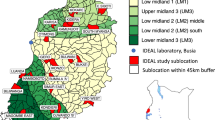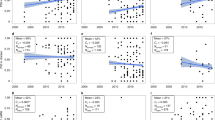Abstract
Although working with human pathogens and zoonotic agents has always carried a certain degree of danger, current events have resulted in an increased focus on the subject, including new regulations. The authors discuss a number of risk assessment and management activities that animal research facilities should use to evaluate strengthen their current programs.
This is a preview of subscription content, access via your institution
Access options
Subscribe to this journal
We are sorry, but there is no personal subscription option available for your country.
Buy this article
- Purchase on Springer Link
- Instant access to full article PDF
Prices may be subject to local taxes which are calculated during checkout
Similar content being viewed by others
References
Institute of Laboratory Animal Resources, National Research Council. Guide for the Care and Use of Laboratory Animals 14–18 (National Academy Press, Washington, DC, 1996).
US Department of Health and Human Services, Centers for Disease Control and Prevention and National Institutes of Health. Biosafety in Microbiological and Biomedical Laboratories 4th edn (eds Richmond, J.Y. & McKinney, R.W.) 53–87 (US Government Printing Office, Washington, DC, 1999).
Barbeito, M.S. et al. Recommended biocontainment features for research and diagnostic facilities where animal pathogens are used. First International Veterinary Biosafety Workshop. Rev. Sci. Tech. 14, 873–887 (1995).
Torok T.J. et al. A large community outbreak of salmonellosis caused by intentional contamination of restaurant salad bars. JAMA 278, 389–395 (1997).
Kolavic S.A., Kimura, A., Simons, S.L., Slutsker, L., Barth, S. & Haley, C.E. An outbreak of Shigella dysenteriae type 2 among laboratory workers due to intentional food contamination. JAMA 278, 396–398 (1997).
Nuclear Regulatory Commission. Report to Congress on abnormal occurrences which occurred between July and September 1995; dissemination of information. Federal Register 61, 7123–7124 (26 February 1996).
Nuclear Regulatory Commission. Incident Investigation Report: Ingestion of Phosphorus-32 at Massachusetts Institute of Technology, Cambridge, MA, Identified on August 19, 1995. [NUREG 1535] Washington, DC, US Nuclear Regulatory Commission, 1995.
Nuclear Regulatory Commission. Preliminary Notification of Event or Unusual Occurrence PNO-1-98-052, Subject: Intentional Ingestion of Iodine-125 Tainted Food (Brown University), November 16, 1998. Washington, DC: US Nuclear Regulatory Commission, 1998.
Nuclear Regulatory Commission. National Institutes of Health issuance of director's decision under 10 CFR Sec. 2.206. Federal Register 62, 50018–50033 (24 September 1997).
Michigan State University Media Communications. Investigation continues in theft of research materials. (18 September 2002). http://www.ur.msu.edu/media/releases/sept02/ researchtheft.html.
USA Patriot Act, 2001. 18 USC Sec 175b.
US Department of Health and Human Services, Centers for Disease Control and Prevention. Additional requirements for facilities transferring or receiving select agents; Final Rule. Federal Register 61, 55189–55200 (24 October 1996).
Public Law 107-188. Public Health Security and Bioterrorism Preparedness and Response Act of 2002 (12 June 2002).
Johnson, B. in Anthology of Biosafety IV: Issues in Public Health (ed. Richmond, J.Y.) 149–166 (American Biological Safety Association, Mundelein, IL, 2001).
Royes, C. & Johnson, B. in Anthology of Biosafety V: BSL-4 Laboratories (ed. Richmond, J.Y.) 131–148 (American Biological Safety Association, Mundelein, IL, 2002).
U.S. Code of Federal Regulations, Title 9–Animals and Animal Products: Part 122, Chapter 1–Animal and Plant Health Inspection Service (APHIS), Department of Agriculture (USDA); Part 122–Organisms and Vectors, Sections: 122.1–122.4.
Department of Transportation, Research and Special Program Administration. Rules and Regulations. Hazardous materials: revision to standards for infectious substances. Federal Register 67, 53117–53144 (14 August 2002).
Author information
Authors and Affiliations
Corresponding author
Rights and permissions
About this article
Cite this article
Richmond, J., Nesby-O'Dell, S. Biosecurity for Animal Facilities and Associated Laboratories. Lab Anim 32, 32–35 (2003). https://doi.org/10.1038/laban0103-32
Received:
Accepted:
Published:
Issue Date:
DOI: https://doi.org/10.1038/laban0103-32



